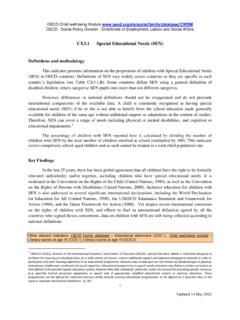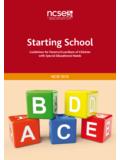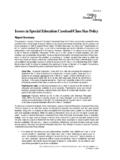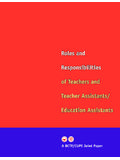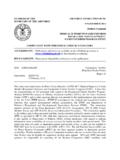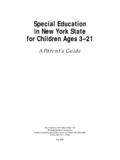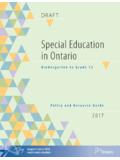Transcription of ICTs IN EDUCATION FOR PEOPLE WITH SPECIAL NEEDS
1 ICTs IN EDUCATION FOR PEOPLE with SPECIAL NEEDSUNITED NATIONS educational , SCIENTIFIC AND CULTURAL ORGANIZATIONUNESCO INSTITUTE FOR INFORMATION TECHNOLOGIES IN EDUCATIONSPECIALIZED TRAINING COURSE MOSCOW 2006 IITE TRAINING MATERIALS2 UNESCOUNESCO Institute for Information Technologies in EDUCATION (IITE) UNESCO Institute for Information Technologies in EDUCATION , 2006 All rights reservedPrinted in the Russian FederationCOURSE TEAM CHAIRMANE dwards, Alistair (University of York, United Kingdom)COURSE TEAMB esio, Serenella(Valle d Aosta University, Italy)Tokareva, Natalia(UNESCO Institute for Information Technologies in EDUCATION )ADVISORY EXPERT TEAMH ansen, Ole(Ministry of EDUCATION , Denmark )Jeppeson, Karl(Iceland University of EDUCATION , Iceland) Naidu, Som(University of Melbourne, Australia)Pillay, Achuthan(University of Melbourne, Australia )Tamargo, Javier(Teacher Training Centre of Gijon, Spain)ICTs in EDUCATION for PEOPLE with SPECIAL NEEDS .
2 Specialized Training CourseThe international team of experts has prepared the specialized training course within the framework of the IITE projectInformation and Communication Technologies in EDUCATION for PEOPLE with SPECIAL NEEDS . The course is intended to provide the specialists involved in EDUCATION of PEOPLE with SPECIAL educational NEEDS (SEN), with an overview of main ways, methods, and principles of information and communication technology (ICT) usagein their professional of the course represent the best international experience, supported by comprehensive training materials andspecial sections with references, summaries, glossary, assignments, and bibliography for supplementary readings. Thecourse offers the opportunities to acquire knowledge and develop practical skills on specifics of ICT application in face-to-face and distance EDUCATION meeting the NEEDS of six main groups of disabilities: physical, visual, hearing, speechand language, cognitive, learning.
3 Particular emphasis of the course is placed upon the basic aspects of ICT policydevelopment in SPECIAL NEEDS EDUCATION (SNE), including promotion of ICT infrastructure, integration of ICTs intocurriculum, training and retraining of ICT specialists in materials presented in the course will be of interest to a wide range of specialists involved in EDUCATION of peoplewith SEN, from high-level policy- and decision-makers to researchers, teachers, programme planners, and opinions expressed in this document are those of the authors and do not necessarily reflect the views of theUNESCO FURTHER INFORMATION PLEASE CONTACT:UNESCO Institute for Information Technologies in Education8 Kedrova St. (Bld. 3), Moscow, 117292, Russian FederationTel.: 7 495 129 2990 Fax: 7 495 129 1225E-mail: OF CONTENTSINTRODUCTORY NOTES ..6 MODULE 1 SPECIAL NEEDS EDUCATION IN INFORMATION AGE.
4 10 Introduction ..10 Goal ..11 Objectives ..11 Readings for Module 1 ..11 UNIT Modern Stage of SNE Development: Implementation of Inclusive EDUCATION .. Equal Opportunities for All: the Drive Toward Inclusion .. Groups of PEOPLE Supported by Inclusion .. Main Steps Toward Inclusive EDUCATION .. Social Approaches to Disability Issues .. Barriers to Inclusive EDUCATION for PEOPLE with SEN .. Ways to Overcome Barriers and Provide Inclusive EDUCATION .. Benefits of Inclusive EDUCATION ..17 Key Terms ..19 Summary ..19 Assessment ..20 References ..21 UNIT Role of Information and Communication Technologies in SPECIAL NeedsEducation .. Changes in the educational system in Information Age .. Equal opportunities for all: digital inclusion of PEOPLE with SEN .. Identification of barriers to learning for students with SEN .. The role of ICTs in SNE.
5 Supporting inclusive EDUCATION through ICT implementation .. Benefits of ICT use in EDUCATION for PEOPLE with SEN ..30 Key Terms ..31 Summary ..31 Assessment ..32 References ..33 MODULE 2 ASSISTIVE TECHNOLOGIES FOR STUDENTS with SPECIAL educational NEEDS ..35 Introduction ..35 Goal ..36 Objectives ..36 Readings for Module 2 ..36 UNIT Description, Classification, and Application of Assistive Technologies .. International Classification of Functioning and Disability and Health .. AT as an Instrument for the Autonomy of Persons with Disabilities .. Classifications of AT .. Technical, Social, and Psychological Aspects of AT Application .. Choosing and Using Appropriate AT .. Sources of Information on Terms ..44 Summary ..44 Assessment ..45 References ..46 UNIT Assistive Technologies for EDUCATION .. Impact of AT Usage on EDUCATION of PEOPLE with SEN.
6 AT for the educational NEEDS of Students with Physical Impairments .. AT for the educational NEEDS of Students with Visual Impairments .. AT for the educational NEEDS of Students with Hearing Impairments .. AT for the educational NEEDS of Students with Language and Speech Impairments .. AT for the educational NEEDS of Students with Cognitive Impairments .. AT for the educational NEEDS of Students with Specific Learning Impairments ..58 Key Terms ..60 Summary ..61 Assessment ..62 References ..63 MODULE 3 DISTANCE TECHNOLOGIES FOR STUDENTS with SPECIAL educational NEEDS ..66 Introduction ..66 Goal ..67 Objectives ..67 Readings for Module 3 ..67 UNIT EDUCATION : New Opportunities for Students with SEN .. Distance EDUCATION and Its Role in Digital Society .. Benefits of Distance EDUCATION for Students with SEN .. Different Technologies Used to Achieve the Benefits of Distance EDUCATION for Students with SEN.
7 Synchronous Communication and Collaboration Asynchronous Communication and Collaboration Terms ..74 Summary ..74 Assessment ..75 References ..76 UNIT Distance EDUCATION for Students with SEN: Approaches to OvercomeAccessibility Barriers .. Accessibility Barriers to Distance EDUCATION for Students with SEN .. Standards of Accessibility in Distance EDUCATION for Students with SEN .. Supporting Accessibility Standards and Providing Accessible Distance EDUCATION for Students with SEN .. Main Techniques of Accessibility Checking in Distance EDUCATION for Students with SEN ..88 Key Terms ..89 Summary ..89 Assessment ..90 References ..915 MODULE 4 ICT POLICY IN SPECIAL NEEDS EDUCATION ..93 Introduction ..93 Goal ..94 Objectives ..94 Readings for Module 4 ..94 UNIT Planning of ICT Policy in SNE .. Objectives, Principles, and Means of ICT Policy Development in SNE.
8 Legal Basis of ICT Policy Development in SNE ..97 Summary ..104 Assessment ..105 References ..106 UNIT Implementation of ICT Policy in SNE .. Promoting ICT Infrastructure for SNE .. Integration of ICTs in SNE Curriculum .. Training and Retraining of ICT Specialists in SNE ..115 Summary ..121 Assessment ..122 References ..123 UNIT Monitoring of ICT Usage in SNE .. Identifying SNE Quality Standards in Digital Age .. Conditions of SNE Quality Improvement by Means of ICTs .. Analysis and Interpretation of Evaluation Results to Improve ICT Policy in SNE ..132 Summary ..134 Assessment ..135 References ..136 CONCLUSION ..138 APPENDIX 1 List of Abbreviations ..139 APPENDIX 2 Glossary of Terms ..142 APPENDIX 3 Illustrations of Main Types of Assistive Technologies in EDUCATION for PEOPLE with SEN ..146 APPENDIX 4 List of Main web Resources.
9 149 APPENDIX 5 Suggested Questions and Tasks for Self assessment and FinalEvaluation ..153 APPENDIX 6 Questionnaire for Specialized Training Course Evaluation ..1546 Relevance of Specialized Training CourseWe live in the historic period when knowledge has turned out to be the most important basic resource. Rapid progressin knowledge and easy access to information are becoming a driving force of economic and social development. TheSecretary-General of the United Nations Kofi Annan has defined the value of information technologies as follows:1 The new information and communications technologies are among the driving forces of globalization. They are bringing peopletogether, and bringing decision-makers unprecedented new tools for development. At the same time, however, the gap betweeninformation haves and have-nots is widening, and there is a real danger that the world's poor will be excluded from the emergingknowledge-based global development of such modern sectors as telecommunications, media, and information technologies affects boththe alterations in the technological sphere and the globalization of the economy, as well as transformssocial relations,culture, and EDUCATION .
10 In the field of EDUCATION , broad introduction of new digital technology presents greatpossibilities and initiates new pedagogical approaches apt to meet the overgrowing demands of modern Society must be created on the principles of social engagement, involvement of all citizens, regardlessof their abilities, background, social status, ethnicity, etc. The common grounds of this approach were expressed inDeclaration of Principles of World Summit on Information Society in the intention to build a PEOPLE -centred,inclusive and development-oriented Information Society, where everyone can create, access, utilize and shareinformation and knowledge, enabling individuals, communities and peoples to achieve their full potential in promotingtheir sustainable development and improving their quality of life, premised on the purposes and principles of theCharter of the United Nations and respecting fully and upholding the Universal Declaration of Human Rights.




